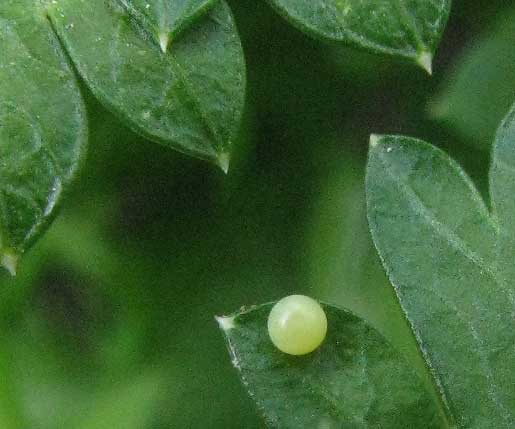Excerpts from Jim Conrad's
Naturalist Newsletter
from the October 20, 2013 Newsletter issued from the Frio Canyon Nature Education Center in the valley of the Dry Frio River in northern Uvalde County, southwestern Texas, on the southern border of the Edwards Plateau; elevation ~1750m (~5750 ft); N29.62°, W99.86°; USA
SWALLOWTAIL EGG ON PARSLEY
A big pot of lush, dark green Parsley lives on Juniper House's deck. When I want to rest my eyes from the computer screen it's a pleasure to look out the window and see the Parsley gorging on sunlight and air, alongside other healthy, happy-looking potted plants. The other day as I worked at the computer a black-colored swallowtail turned up flitting above the Parsley, every couple of seconds dipping her abdomen's tip onto some of the top leaves. She was laying eggs. When she left, I went out to look for an egg, and on one of the topmost leaves saw what's shown below:

Black Swallowtail butterflies are known to place their eggs on plant members of the Parsley Family, the Apiaceae, so all along I figured that the egg was of that species. However, another mostly black butterfly is common here, the Pipevine Swallowtail, so when I sent the egg picture to volunteer identifier Bea in Ontario, I asked her if she could be sure it wasn't a Pipevine Swallowtail egg.
Bea pointed out that Pipevine Swallowtails lay orange eggs, while those of Black Swallowtail eggs are white, like ours. Also, Pipevine Swallowtail larvae eat ONLY plants in the Pipevine Family, while we know that Black Swallowtail caterpillars feed on the Parsley Family.
So, we're fairly sure that what we're showing here is the egg of a Black Swallowtail, whose incubation period is 11-13 days.
from the August 15, 2004 Newsletter issued from the woods just south of Natchez, Mississippi, USA
A DISCRIMINATING BLACK SWALLOWTAIL
The other day a pretty Eastern Black Swallowtail butterfly, PAPILIO POLYXENES, flitted into one of my gardens and began zipping from plant to plant, briefly hovering immediately above each plant, never staying longer than a second in any one spot. When the butterfly got to my parsnips, suddenly she dropped down and in half a second touched her rear end to a parsnip leaflet -- never stopping beating her wings -- and then was off to other plants. She was clearly laying eggs.
The noteworthy thing was that she never laid her eggs on anything other than my parsnips, which had growing among them several weeds and some sprawling sweet- potato vines. She was moving too fast and low to identify leaves by vision so it was clear that she was choosing parsnip leaves by odor or some other means besides vision.
My books say that Eastern Black Swallowtail caterpillars are found on two plant groups: Members of the Parsley or Carrot Family, and members of the Citrus family. My parsnips are proud members of the Parsley Family.
Seeing the Parsley Family and Citrus Family linked in this way, I remembered an ecology class from long ago in which it was pointed out that these two fairly unrelated families both contain three "essential oils" attractive to Black Swallowtail larvae. The oils are methyl chavicol, anethole and anisic aldehyde, and all have very similar molecular structure.
Just think of the mamma swallowtail flitting in the sunlight, so vulnerable to these invisible molecules of a certain magical shape that the merest whiff of them instantly causes her abdomen to convulse downward and her wings to momentarily hover, as an egg squirts out exactly on the spot where the molecules gather.
After the mamma had left I went and looked at my parsnip leaflets. Pinhead-size, oval, translucently yellowish-cream-colored eggs were evident all down my row of parsnips, but there wasn't a single egg on any non-parsnip leaf.
from the June 22, 2006 Newsletter issued from Polly's Bend, Garrard County, in Kentucky's Bluegrass Region, USA
BLACK SWALLOWTAIL CHRYSALIS
Tuesday I picked up a piece of plywood with a butterfly chrysalis (KRIS-uh-lus) stuck to it with cobwebby silk. An immobile chrysalis develops between a metamorphosing butterfly's caterpillar and adult stages. In other insects this stage is often referred to as the pupa. However, butterflies are so special that their pupal stage has its own name.
I wasn't sure what kind of butterfly would emerge from the chrysalis so, as usual, I Googled it, using Google's image feature. I searched on the keyword "chrysalis" and after viewing two or three pages of thumbnail photos saw exactly what mine looked like. It was the chrysalis of the Eastern Black Swallowtail butterfly, PAPILO POLYXENES. Below, you can see my own scanning of the chrysalis, which is nice because it shows fine details of the developing adult inside, including veins in the expanding wings:
